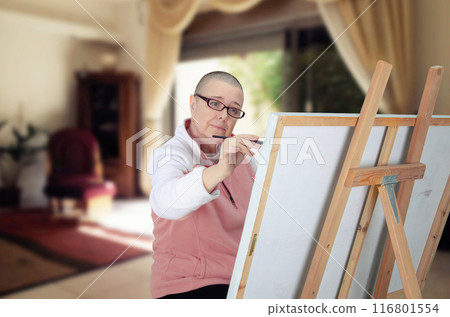The woman in the photo recently completed an intense course of chemotherapy as part of her ongoing battle against breast cancer. The treatment left her physically drained, but it was the emotional toll that weighed the heaviest. The fear, the uncertainty, and the constant questioning of “what’s next?” were her constant companions. As days blurred into weeks, she realized that she needed something to focus on, something to distract her mind from spiraling into dark, depressing thoughts.
Her oncologist recommended therapy, but it was her psychologist who suggested something more creative—art therapy. The concept of using creativity to heal intrigued her. Though she hadn’t drawn since her school days, she decided to give it a try. What did she have to lose?
Her family fully supported the idea. Her husband, always her rock, immediately went out and bought her everything she could need: brushes, paints, an easel, and large canvases. He even joked that their home would soon resemble an artist’s studio. Their children chimed in with encouraging words, excited to see their mother’s creations. She wasn’t sure how serious she was about it at first, but with her family’s backing, she felt motivated to give it her best shot.
(c) verbaska - Stock Image PIXTA -
During the quiet moments when the house was empty, she would set up her art supplies. At first, it felt foreign to hold a brush, to stare at a blank canvas, unsure where to start. But she discovered an endless amount of tutorials and drawing lessons online, from basic shapes to advanced techniques. Slowly, her confidence grew.
Each brushstroke on the canvas became a release, a way to pour out her emotions without having to speak them. Time seemed to melt away as she painted, each completed piece not just a work of art but a testament to her resilience. The bright, bold colors she used stood in stark contrast to the dullness she had felt during her treatment, signaling that a new chapter had begun. As she painted, she imagined her future not as a cancer patient, but as an artist, a creator, someone who still had so much left to give and live for.
Her art became her escape, her therapy, her new passion. She found herself excited about each new day, planning her next project, imagining what she would paint next. The therapeutic process of creating something out of nothing was transformative. There was no longer time to dwell on what-ifs or worst-case scenarios. She was too busy living, too busy creating.
The more she painted, the more she realized this wasn’t just a hobby; it was a lifeline. It gave her a sense of purpose that went beyond her illness, beyond the treatments and the medical appointments. She wasn’t just a patient anymore. She was an artist, and she had big plans.
She started dreaming of holding a small exhibition or maybe even selling her artwork online. She imagined her paintings hanging in the homes of people who, like her, needed a reminder of hope and resilience. She imagined her art helping others heal, just as it had helped her.
This new life of hers was brighter, filled with possibilities. Art had given her something to look forward to. She felt alive again in a way she hadn’t in years. And the best part? She wasn’t just fighting cancer anymore—she was building a new life. A life where she wasn’t defined by her illness but by the beauty she could create. A life where she chose to focus on joy, creativity, and the things that truly mattered.
In her mind, she had already won. The cancer might still be there, but it no longer controlled her. Her art was her rebellion against the darkness, her way of saying that no matter what, she would live her life on her terms. And for the first time in a long time, she looked forward to the future with a smile.

